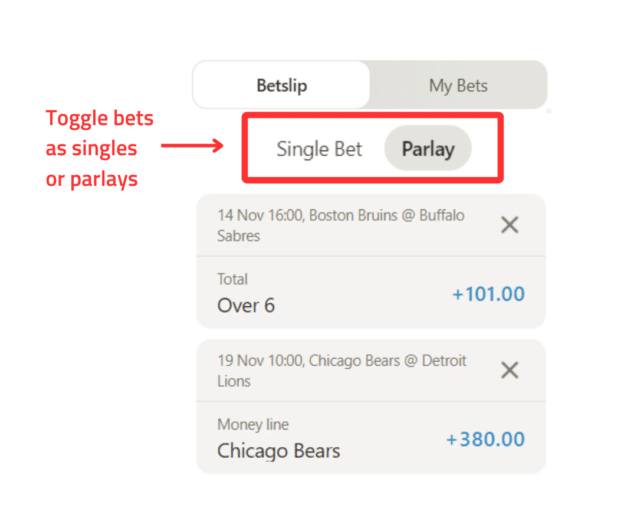
What Is A Parlay Bet? Parlay Sports Betting Explained
UNIT 3.7 – WHAT IS A PARLAY BET
Introduction To Parlays
A parlay bet, also known as an accumulator, is a riskier but potentially more lucrative form of sports betting available at most sportsbooks. Parlay betting offers the opportunity to multiply your winnings by combining multiple single bets into one. That said, because of their profitable nature, parlays also come with their own set of complexities and risks that sports bettors should be familiar with. In this article, we’ll discuss what parlay bets are, how they work, the potential rewards, and important considerations for bettors. In all, this article will cover:
This article is part of The Ultimate Beginner’s Guide to Sports Betting, a course by Canada Sports Betting.
What Is A Parlay Bet?
A parlay bet is a single wager that combines two or more individual bets, known as “legs” or “selections,” into one bet slip. To win a parlay bet, all the included legs must be correct; each individual leg must win on their own. If even one selection is wrong, the entire parlay is lost. Parlays can include any types of bets, including point spreads, the moneyline, totals (over/under), or prop bets.
How Do Parlay Bets Work?
When parlays are successful, they have the potential to return much more in profit as the odds compound with every winning leg. In addition, parlays are risky, and therefore inherently more lucrative. As with any form of betting, the riskier the bet, the more money it tends to pay out.
Bettors can create a parlay by selecting multiple outcomes from different games or events. All your selections will be added to your bet slip, where bettors can then select the parlay toggle before checking out. Bettors can then place a fixed stake on the parlay, and if it wins (i.e. all individual legs win), you’ll receive a payout based on the odds of each selection.

When you select the parlay option, the odds for each individual selection are multiplied together to determine the overall odds for the parlay. The more selections you add, the higher the potential payout, but also the lower the likelihood of winning. This is how parlays offer the potential for substantial payouts, often significantly higher than individual bets. That said, the risk is also higher because you must win every leg to win the parlay. Sportsbooks love to offer parlays because their profit margin increases substantially when more legs are added. Largely, this is due to implied probability, which says the sportsbooks’ likelihood of winning is much higher than the bettor’s.
How Are Parlay Payouts Calculated?
Calculating a parlay payout can be a bit complicated because it involves multiple bets on different events, and the payout depends on the odds of each individual bet. To calculate the payout of a parlay, follow these steps:
- Convert all odds to decimal odds.
- Multiply all the decimal odds together.
- Multiply the total by your stake.
- Subtract your original stake to get the parlay odds.
Let’s look at an example. Suppose you stake $50 on the following parlay:
- The Seattle Seahawks to win their next game (-200).
- The Los Angeles Lakers to win their next game (-140).
- Sean O’Malley to win a UFC fight (+300).
Here’s how you can calculate the parlay payout, including the conversion to decimal odds:
Let’s look at one last example. Say you’re given odds of 1.5 and want to know what this is in American Odds. Let’s plug 1.3 into our formula:
Convert to decimal odds:
- Seahawks (-200): Decimal odds = (100 / 200) + 1 = 1.50
- Lakers (-140): Decimal odds = (100 / 140) + 1 = 1.71
- Sean O’Malley (+300): Decimal odds = (300 / 100) + 1 = 4.00
Multiply the decimal odds together:
- Payout = 1.50 * 1.71 * 4.00 = 10.26
Multiply your stake by the total:
- Total Payout = 10.26 * $50
- Total Payout = $513.00
Subtract your original stake to get the parlay odds.
- Net Payout = $513.00 – $50
- Net Payout = $463
So, if all three of your bets in the parlay are successful, you would win $463.00 in profit for betting $50. Remember that in a parlay, all selections must win for you to receive a payout. If any one of your selections loses, the entire parlay bet is lost.
Key Considerations for Parlay Betting
As a new bettor, remember that parlays are inherently riskier than single bets because every selection needs to be correct. As such, it’s a good idea to manage your risk by not including too many legs in one parlay – especially when starting to bet for the first time. If one of your parlay selections ends in a push (a tie), it will typically be removed from the parlay, and the odds will be recalculated based on the remaining selections.
When creating a parlay, in-depth research and analysis are important steps to take to ensure you’re making an informed bet. Each leg should be based on a well-informed prediction. As with any kind of bet, parlays should be seen as fun and potentially rewarding, but they shouldn’t be relied upon as a primary betting strategy. Finally, as always, set a budget and stick to it.

